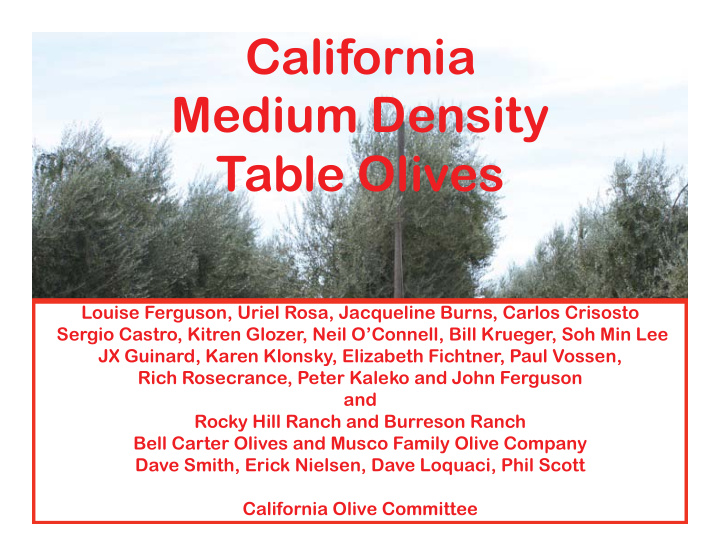



California Medium Density Table Olives Louise Ferguson, Uriel Rosa, Jacqueline Burns, Carlos Crisosto Sergio Castro, Kitren Glozer, Neil O’Connell, Bill Krueger, Soh Min Lee JX Guinard, Karen Klonsky, Elizabeth Fichtner, Paul Vossen, Rich Rosecrance, Peter Kaleko and John Ferguson and Rocky Hill Ranch and Burreson Ranch Bell Carter Olives and Musco Family Olive Company Dave Smith, Erick Nielsen, Dave Loquaci, Phil Scott California Olive Committee
Traditional Orchards: 96 – 139 t/a
Hedgerow Orchard #2: 12’ X 18’ = 202 trees/acre
What Are the Differences? • Cultivar: ‘Manzanillo’ • Production Costs and Breakdown • Spacing • Yields • Olive Size = Thinning and Irrigation • Olive Fly Tolerance • State of Maturity at Harvest = FRF • Olive Quality at Delivery • Disease Susceptibility • Mechanical Harvesting Technology
What Are the Differences? • Cultivar: ‘Manzanillo’
California Black Ripe ‘Manzanillo’ Table Olive
What Are the Differences? • Cultivar: ‘Manzanillo’ • Production Costs and Breakdown
Cost to Produce Table Olives $4,543/acre (2009) ��������� ��������� ��������� ��������� ����� ������� ����� ��������� ����� �������� �� ��������������������� ������� Abscission Program for CA Table Olives
What Are the Differences? • Cultivar: ‘Manzanillo’ • Production Costs and Breakdown • Spacing • Yields
12 Feet 6 Feet 3 feet New Orchards: 12’ X 18 (200+ T/ac)
What Are the Differences? • Cultivar: ‘Manzanillo’ • Production Costs and Breakdown • Spacing • Yields • Olive Size = Thinning and Irrigation
Set fruit: will be an olive
Heavy Crop Set: if representative of total tree and orchard will produce a heavy crop of small fruit.
Chemical Thinning of Olives Removes fruit: changes leaf to fruit ratio = larger fruit
Fruit Size Method – 1/8 to 3/16 inch
Preharvest Irrigation
What Are the Differences? • Cultivar: ‘Manzanillo’ • Production Costs and Breakdown • Spacing • Yields • Olive Size = Thinning and Irrigation • Olive Fly Tolerance
hole � \ � No Tolerance!!
What Are the Differences? • Cultivar: ‘Manzanillo’ • Production Costs and Breakdown • Spacing • Yields • Olive Size = Thinning and Irrigation • Olive Fly Tolerance • State of Maturity at Harvest = FRF
Physiologically Immature Fruit: FRF >0.5 Kg
Overcome Biological Constraints Find a selective abscission agent: • Use model abscission agents as treatments • Define seasonal response • Examine physiological, molecular changes • Select compounds based on metabolic changes • • Focus on � natural �� compounds • Screen available compounds Incorporate into a � mechanical harvesting system � : • Define effective application parameters • Establish tree architecture criteria Abscission Program for CA Table Olives
What Are the Differences? • Cultivar: ‘Manzanillo’ • Production Costs and Breakdown • Spacing • Yields • Olive Size = Thinning and Irrigation • Olive Fly Tolerance • State of Maturity at Harvest = FRF • Olive Quality at Delivery
Hand Harvest 24 hours Machine Harv
What Are the Differences? • Cultivar: ‘Manzanillo’ • Production Costs and Breakdown • Spacing • Yields • Olive Size = Thinning and Irrigation • Olive Fly Tolerance • State of Maturity at Harvest = FRF • Olive Quality at Delivery • Disease Susceptibility
Olive knot, caused by Pseudomonas savastanoi pv. savastanoi , is the most common bacterial disease of olive trees. Characteristic symptoms are galls, usually developing on twigs and branches.
What Are the Differences? • Cultivar: ‘Manzanillo’ • Production Costs and Breakdown • Spacing • Yields • Olive Size = Thinning and Irrigation • Olive Fly Tolerance • State of Maturity at Harvest = FRF • Olive Quality at Delivery • Disease Susceptibility • Mechanical Harvesting Technology
“Harvest Method determines the tree training method.” Ricardo Gucci (2009)
Hedgerow Orchard #1: 12’ X 26’ = 139 Trees/acre
12 feet
6 feet
3 Feet Mechanical Pruning Reduces Yield!
DSE 006, 007, 008, 2010 4/6/11
Hedgerow Orchard #2: 12’ X 18’ = 202 trees/acre
Progress from 2006 - 2010 Achieved: Initial Objectives: � Decrease fruit � Fruit damage damage eliminated � Increase harvester � Harvester efficiency efficiency: < 64% � Engineering � Tree pruning � Abscission agent
Current Objective: 2011 � Increase harvester efficiency > 64%: � Engineering � Canopy Contact � T Trunk Shaker s
Oxbo in Spain: 2011
Current Objectives: 2011 � Increase harvester efficiency > 64%: � Pruning before and during harvest: � 139 trees/acre hedgerow � 202 trees/acre hedgerow
Hedgerow Orchard #1: 12’ X 26’ = 139 Trees/acre
Hedgerow Orchard #2: 12’ X 18’ = 202 trees/acre
Pruning during harvest to increase % removal efficiency
Abscission Agent Tree ee Training T and Pruning Harvester
Recommend
More recommend